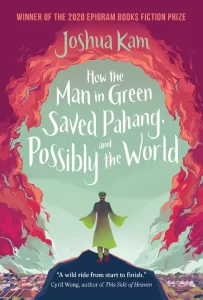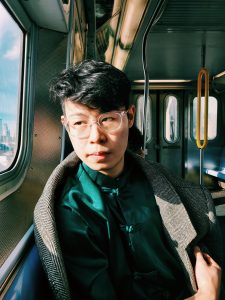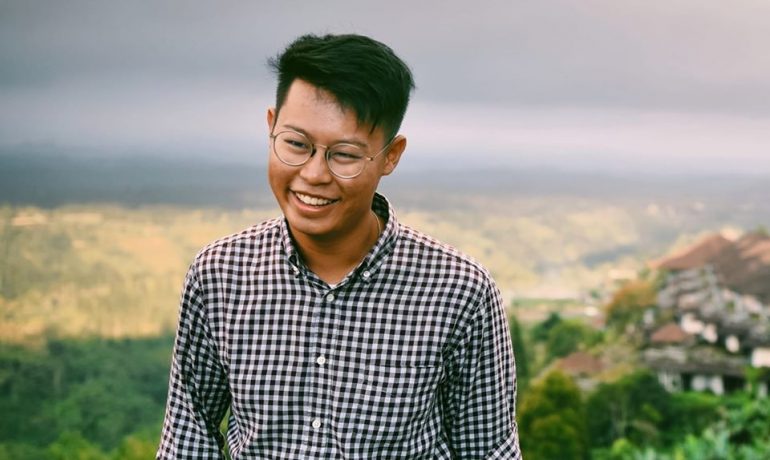Two years on, Epigram Prize winner Joshua Kam looks back on his first novel’s publication journey and the radicality of queerness in Malaysian fiction.
By JY Tan
On a lazy July afternoon, I met Joshua Kam at a cafe in Penang. His first novel, How the Man in Green Saved Pahang, and Possibly the World, had been published in 2020 after he became the youngest winner to-date of the Epigram Books Fiction Prize (EBFP).
Born a KL-lite with family ties in Kuantan and Penang, Kam spent his early childhood in Montana and returned to Kuala Lumpur for 15 years before returning to study history at Hope College, Michigan. He was pursuing a Masters in Southeast Asian studies at the University of Michigan in 2020 and is currently a PhD student in Asian Studies at the University of Michigan.

The debut of Man in Green (and Covid-19)
Given that Man in Green was published in 2020, it was inevitable that the pandemic would present additional obstacles on Kam’s long road to publication. His first obstacle, however, emerged long before Covid-19 sent the world into lockdown—he had to wrangle with the International Postal System while abroad.
“I was doing my research in Indonesia shortly before the deadline,” Kam recounted, “so I had to ship the hard copies of my manuscript from there, and pray they reached Singapore safely.”

Source: George Town Literary Festival
After winning the EBFP, Kam was invited to do a podcast episode for the 2020 George Town Literary Festival called “Road Trips of the Imagination”. Sitting down and talking with Arif Rafhan and Adriana Nordin Manan (the other two speakers presented in “Road Trips”) was a nice experience for him. Recording the episode, however, felt surreal as it was mostly done online. As we continued to talk, Kam recalled feeling the same about becoming a published author during the pandemic.
“There was a trade-off of sorts,” Kam said. “More people were reading than before, but there were also less opportunities to do publicity events.”
Queerness in Malaysian fiction
Despite making waves upon publication for its queer representation, Man in Green was not the first Malaysian story to place queer characters front and centre. Jit Murad’s play, Spilt Gravy on Rice, featured a gay man as a prominent side character. The protagonist of Zen Cho’s Black Water Sister is lesbian. But Man in Green is the first (at least, in recent memory) story with a queer religious figure—specifically, al-Khidir the Green Prophet, who makes frequent appearances in Southeast Asian Muslim texts. Naturally, conservative readers took offence when their assumptions of al-Khidir’s sexuality were challenged, though not to the extent that Kam had feared.
“I was a bit worried for me and my family’s safety at first,” he admitted. “But I think most of the reactions to Man in Green was that of shock. It’s easy to dismiss a queer story that distances itself from Malaysia while criticising it, but Man in Green is a story that embraces it. It says, ‘These people have always been here, this is what Malaysia’s always been like, and I love it all the same’.”

There are many ways to do queer activism, but Kam remarked that this is the method he’s most comfortable with. Not by advocating in the courtroom or on the streets, but by presenting what Malaysia could be on the page. Considering that normalising queerness in fiction is a radical act in and of itself, Man in Green constitutes an important step towards queer acceptance in Malaysia, and possibly the world.
Moving forward
Despite the success of Man in Green, Kam considers himself an academic first and writer second. When asked about his plans for the future, Kam disclosed that he’s doing research on Malaysian food history, “which involves getting paid to eat Malaysian food all over the country,” he joked. He is also working on a second novel while dividing his time between Malaysia and the US.
“I started writing it during the pandemic, when I was stranded in the US,” he said. “It’s set in Michigan about Asians in America.”
JY Tan is a freelance translator by day and writer by night. She hopes to get her first novel published someday.
All photos courtesy of Joshua Kam.

